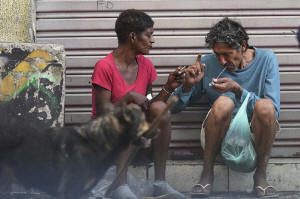Sao Paulo moves to end area known as Crackland as residents scatter and
cry foul against police
[May 27, 2025]
By MAURICIO SAVARESE
SAO PAULO (AP) — Marcelo Colaiácovo was driving to his bar in Downtown
Sao Paulo on a recent May afternoon when he noticed something unusual:
the hundreds of drug users that for years roamed around the neighborhood
were all gone. He walked around for 10 minutes finding no trace of them.
Also gone was the stench of their waste being cleaned by city hall
staffers.
“I felt this strange peace,” said the 42-year-old Sao Paulo resident.
“Everyone had disappeared. But how come?”
Colaiácovo's bar-museum is located in one of the edges of Cracolandia,
or Crackland, a sprawling downtown Sao Paulo area that for decades has
been home to thousands of drug users, often lying on the ground or
jaywalking with pipes between their lips.
But by May 12 the scene had changed.
Only police officers were seen where crack users dominated for decades.
Shop owners and residents who worried about muggings were chatting
outside. Pavement that until recently featured scattered shoes, single
socks, broken pipes and, sometimes, feces seemed spotless. The makeshift
shelters, made of cardboard and fabric, were gone, and some of the
graffiti on deteriorated buildings of Crackland, once a backdrop to the
human drama, can finally be seen.
The transformation that stationed police officers in the area and scared
residents into other parts of the city is the result of an aggressive
local government initiative to change the region for good.

Experts caution, however, that the cleanup carried significant costs:
police brutality, the spread of security risks to other areas and the
neglect of treatment and protection to drug users, who are not
criminals. Instead, they say, Crackland residents have only scattered
and will inevitably return.
‘We can’t even carry a blanket'
Residents told The Associated Press that police aggression has escalated
since earlier this year under Gov. Tarcisio de Freitas and Mayor Ricardo
Nunes. They say officers more frequently are using batons, preventing
them from carrying bags where drugs could be hidden, closing several
local pensions and even threatening to kill them. About a fourth of
neighboring slum, where drug traffickers are reportedly based, has been
removed.
Nearly two weeks after drug users vanished from the main Crackland area,
hundreds have been spotted in smaller pockets around Sao Paulo's old
city center. Social media videos show some attempting to return at night
to their former drug use spot, now a 24/7 police-protected area. But all
attempts have failed.
Many hope to soon return to the area they occupied for decades —
provided police brutality wanes and authorities lose their grip of the
region, as has happened in the past.
“My guitar is in the mud because of a criminal wearing blue," said
Rogério, a tearful man in a dirty shirt and yoga pants, who didn't
provide his surname due to fear of retribution. "I have nothing against
the law. But the law has to understand we live there. Now we have to
roam, it's horrible. We can't enter where we lived, we can’t even carry
a blanket.”
‘It's about people’
Crackland is located in what was once part of Sao Paulo’s old city
center. The decline of the region began in the 1960s, as business moved
to Paulista Avenue, a more central artery, and industries relocated to
the cheaper outskirts. For about two decades, until the mid 1980s, low
budget film companies moved in, earning the region the nickname of
“Garbage Mouth.” Drug users first arrived about three decades ago.

[to top of second column]
|

A drug addict smokes crack cocaine in a downtown area popularly
known as "Crackland" in Sao Paulo, Tuesday, May 20, 2025. (AP
Photo/Andre Penner)

Brazilian researchers say Crackland emerged in the 1990s due to a
confluence of two factors: the proximity of a major transportation hub,
encompassing buses, subways and trains, and widespread mass killings in
the city’s most impoverished districts, which forced residents to
congregate in the downtown’s most dilapidated sector.
For much of the last 30 years, shop owners and residents feared being
mugged. Today, the area the size of 10 soccer fields in Sao Paulo’s old
city center, is spotless and silent.
Lieutenant Sao Paulo Gov. Felicio Ramuth, who was picked by Gov. de
Freitas to clean up Crackland, said last week that there was no police
brutality linked to the scattering of residents.
“We had 50 police raids at the scene (and) 1,000 criminals were jailed,”
he told daily O Estado de S.Paulo on Wednesday. “We did not receive any
accusation of police brutality.”
Ramuth said that 1,200 drug users who were in the area until a few weeks
ago are now under treatment in clinics, but offered no evidence to
support his claim. He added that he will deem Crackland free of drug
users if its current condition remains for the next six months.
Gov. De Freitas, a former minister under President Jair Bolsonaro, is
reportedly considering running against President Luiz Inácio Lula da
Silva in the 2026 presidential election. His rivals claim he stands to
gain political capital by ending Crackland, which could also make way
for a 5-billion Brazilian reais ($900 million) project to relocate about
60 state government buildings to the area.
Critics of the government's strategy to end Crackland are crying foul.
Catholic priest Júlio Lancelotti, who has worked with homeless people
for most of his 76 years, said police brutality and the scattering of
drug users will not solve the problem.
“It is not right to make political propaganda to say Crackland
disappeared," Lancelotti said. "Crackland is not a physical area, it's
about people. They are being taken to isolated regions, they are not
going to clinics.”

The city hall of Guarulhos, a city within the Sao Paulo metropolitan
area, expressed concern in a recent statement about the accusations by
Lancelotti and other activists who claim that the residents of Crackland
“had been brought and abandoned” there. It added it will investigate the
case.
Sao Paulo Mayor Nunes denied any wrongdoing.
‘The problem will grow’
Giordano Magri, a University of Sao Paulo researcher specializing in
urban issues, said the current crackdown on Crackland aims to remove the
infrastructure for drug users to survive in the area, but they will
eventually find similar conditions elsewhere.
“Since the governor and the mayor became more authoritarian, that
ecosystem is gone. But they can't do this forever,” said Magri, who
added that people leaving Crackland will have more than 70 smaller spots
across the city to relocate to.
Rogério, the man whose guitar was broken, fears the situation could get
worse in the coming days as hundreds seek to return.
“We are real people. I say that with a sour heart. I am garbage, I
know,” he said. “But now that they are scattering the garbage, the
problem will grow.”
All contents © copyright 2025 Associated Press. All rights reserved |